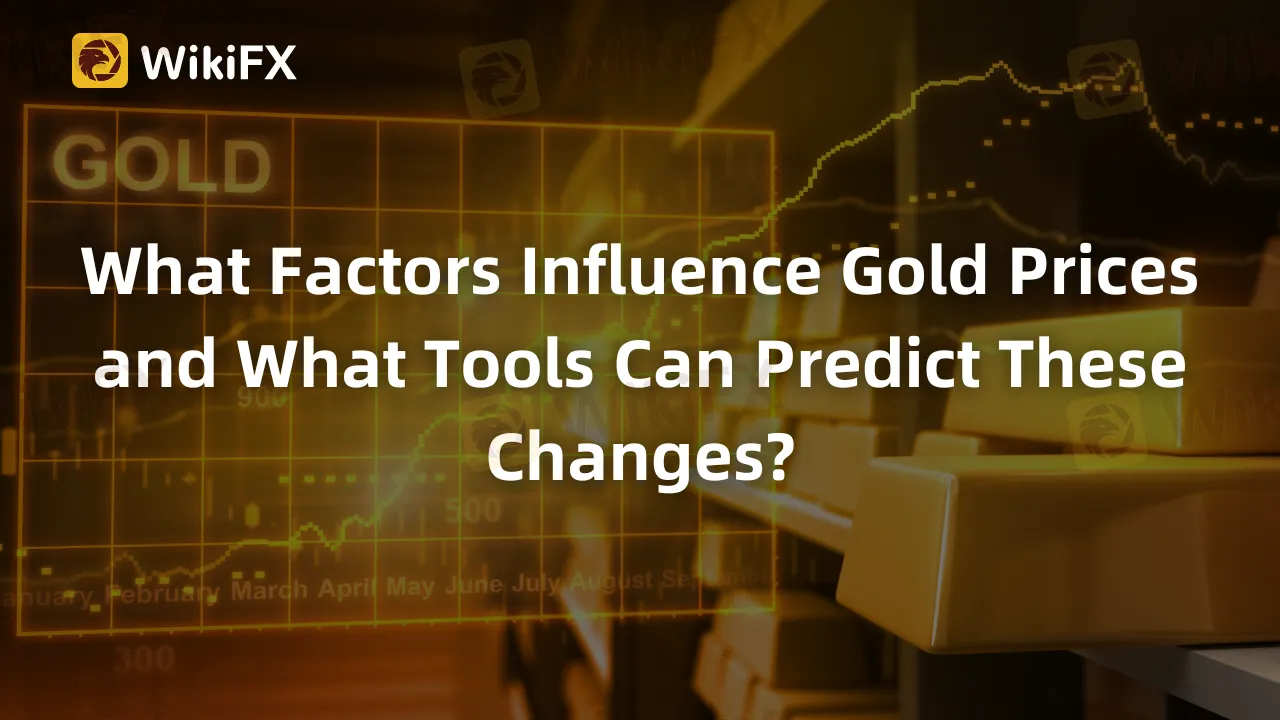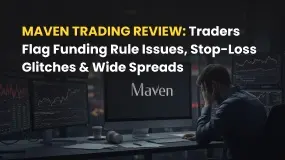简体中文
繁體中文
English
Pусский
日本語
ภาษาไทย
Tiếng Việt
Bahasa Indonesia
Español
हिन्दी
Filippiiniläinen
Français
Deutsch
Português
Türkçe
한국어
العربية
What Factors Influence Gold Prices and What Tools Can Predict These Changes?
Abstract:Gold prices are influenced by factors including supply and demand, economic indicators, geopolitics, market performance, currency values, central bank policies, investor sentiment, and seasonality. Predicting these prices involves fundamental and technical analysis, news interpretation, historical data, machine learning, and various trading strategies.

Gold is a fascinating asset class due to its unique properties. It is both a commodity and a form of money, making its price subject to a wide range of influences. From macroeconomic factors, geopolitics, and supply and demand dynamics, to investor sentiments, many elements affect the daily gold price movements. But the complexity doesn't stop there. Tools such as fundamental and technical analysis, machine learning algorithms, and more, have been developed to predict these price movements. This article dives deep into these influencing factors and predictive tools, providing insights into the gold market dynamics.
Factors Influencing Daily Gold Price Movements
Supply and Demand Balance: A primary influence is the balance between gold's supply and demand. Higher demand or lower supply, maybe due to decreased mining activities or increased buying from central banks, can push prices up, while higher supply or lower demand can depress prices.
Economic Indicators: Inflation and GDP growth rates are critical economic indicators affecting gold prices. Gold is seen as an inflation hedge, so rising inflation often lifts gold prices. Conversely, stronger GDP growth signals a robust economy, potentially reducing gold's appeal as a safe-haven asset and lowering its price.
Geopolitical Instability: Gold is traditionally a safe-haven asset. During times of geopolitical instability or economic uncertainty, investors flock to gold, driving up its price.
Performance of Other Markets: Gold often negatively correlates with stock markets and positively correlates with bond markets. Hence, downturns in stock markets or rising bond yields may lead to higher gold prices, and vice versa.
Currency Value Fluctuations: Gold prices also correlate inversely with the US dollar. A stronger dollar makes gold more expensive for other currency holders, potentially decreasing demand and lowering prices, and vice versa.
Central Bank Policies: Central banks hold vast gold reserves, and their buying and selling can significantly impact prices. Additionally, their monetary policies, like interest rates and quantitative easing, influence gold prices due to their role as safe-haven and non-interest-bearing assets.
Investor Sentiment: Market sentiment and risk tolerance can sway gold prices. Fear and risk aversion can drive prices up, while optimism and risk-taking can push them down.
Seasonality: Certain times of the year, like the Indian wedding season or Chinese New Year, see increased gold demand, impacting prices.

Analyzing and Predicting Gold Price Movements
Fundamental Analysis: This method studies the macroeconomic factors, including the ones discussed above, to predict gold prices. However, the large number of factors and their potential interactions make this a complex task.
Technical Analysis: This form involves studying price charts and using technical indicators like moving averages or momentum oscillators to predict future price movements. Technical analysis assumes that all information is already reflected in the price and that patterns tend to repeat.
Utilizing Financial News and Events: News and events can significantly affect gold prices. Traders often use news analysis tools to interpret the potential impact of news on gold prices.
Using Historical Data: Historical price data can be studied to identify patterns or trends that may predict future movements. However, past performance doesn't guarantee future results, making this a supplementary tool at best.
Machine Learning Algorithms: Machine learning can analyze large datasets, identify complex patterns, and make predictions, making it a promising tool for predicting gold prices. However, these algorithms require extensive data and fine-tuning.
Currency Value Fluctuations: Traders often analyze currency values, especially the US dollar, to predict gold prices. A falling dollar could indicate rising gold prices.
Central Bank Policies: Changes in these policies are closely watched by gold traders. Lower interest rates or increased quantitative easing may indicate a rise in gold prices.
Investor Sentiment: Sentiment analysis tools are used to gauge market sentiment, which can significantly influence gold prices. Increased fear or risk aversion usually points to higher gold prices.
Seasonality: Seasonal patterns in gold demand can be analyzed to predict price movements. However, these patterns may not always hold due to other influencing factors.
Gold Trading Strategies for Predicting Daily Price Movements
Trend Following: This strategy involves identifying a trend in gold prices and assuming it will continue. Traders use technical indicators like moving averages to identify trends.
Mean Reversion: This strategy assumes that gold prices will return to their mean or average price over time. Traders use statistical techniques to identify when prices have deviated significantly from the mean and may likely revert.
Breakout Trading: This strategy involves identifying key price levels that if breached, could lead to significant price movements. Traders often use chart patterns like triangles or head and shoulders to identify these levels.
News Trading: This strategy involves trading based on news or events that could significantly impact gold prices. Traders use news analysis tools to stay updated and interpret the potential impact of news.
Sentiment Trading: This strategy involves trading based on market sentiment. Traders use sentiment analysis tools to gauge market sentiment.
Quantitative Trading: This strategy involves using quantitative analysis or machine learning algorithms to predict gold prices and trade based on these predictions.
Conclusion
Predicting daily gold price movements is a complex task, requiring an understanding of various influencing factors and the ability to effectively use different predictive tools. Despite the complexity, it's a fascinating field, blending economics, finance, geopolitics, and technology, with the ultimate goal of deciphering the seemingly enigmatic gold price puzzle. While it's impossible to predict gold prices with absolute certainty, these tools and insights can certainly help investors and traders make more informed decisions.
Download and install the WikiFX App on your smartphone to stay updated on the latest news.
Download the App here: https://social1.onelink.me/QgET/px2b7i8n

Disclaimer:
The views in this article only represent the author's personal views, and do not constitute investment advice on this platform. This platform does not guarantee the accuracy, completeness and timeliness of the information in the article, and will not be liable for any loss caused by the use of or reliance on the information in the article.
Read more

M&G Review: Traders Report Fund Scams, Misleading Market Info & False Return Promises
Applying for multiple withdrawals at M&G Investments but not getting it into your bank account? Do you see the uncredited withdrawal funds out of your forex trading account on the M&G login? Does the customer support service fail to address this trading issue? Does the misleading market information provided on this forex broker’s trading platform make you lose all your invested capital? Were you lured into investing under the promise of guaranteed forex returns? These issues have become highly common for traders at M&G Investments. In this M&G review article, we have echoed investor sentiments through their complaint screenshots. Take a look!

INZO Broker MT5 Review 2025: A Trader's Guide to Features, Fees and Risks
INZO is a foreign exchange (Forex) and Contracts for Difference (CFD) brokerage company that started working in 2021. The company is registered in Saint Vincent and the Grenadines and regulated offshore. It focuses on serving clients around the world by giving them access to popular trading platforms, especially MetaTrader 5 (MT5) and cTrader. The company offers different types of trading instruments, from currency pairs to cryptocurrencies. It aims to help both new and experienced traders. Read on to know more about it.

Global Guide to Finding Forex IBs/Brokers — Share Your Pick and Win Big!
Dear forex enthusiasts, are you also troubled by these questions? “In India, can’t find a reliable IB? What should I do?” “With so many brokers, which one offers the lowest spreads and fastest withdrawals?” “Want to connect with local forex enthusiasts but don’t know where to start?” Now, leave these challenges to us! Share your experience and win exciting rewards!

Maven Trading Review: Traders Flag Funding Rule Issues, Stop-Loss Glitches & Wide Spreads
Are you facing funding issues with Maven Trading, a UK-based prop trading firm? Do you find Mavin trading rules concerning stop-loss and other aspects strange and loss-making? Does the funding program access come with higher spreads? Does the trading data offered on the Maven Trading login differ from what’s available on the popular TradingView platform? These are some specific issues concerning traders at Maven Trading. Upset by these untoward financial incidents, some traders shared complaints while sharing the Maven Trading Review. We have shared some of their complaints in this article. Take a look.
WikiFX Broker
Latest News
2 Malaysians Arrested in $1 Million Gold Scam Impersonating Singapore Officials
Moomoo Singapore Opens Investor Boutiques to Strengthen Community
OmegaPro Review: Traders Flood Comment Sections with Withdrawal Denials & Scam Complaints
An Unbiased Review of INZO Broker for Indian Traders: What You Must Know
BotBro’s “30% Return” Scheme Raises New Red Flags Amid Ongoing Fraud Allegations
The 5%ers Review: Is it a Scam or Legit? Find Out from These Trader Comments
WikiEXPO Dubai 2025 Concludes Successfully — Shaping a Transparent, Innovative Future
Admirals Cancels UAE License as Part of Global Restructuring
Forex Expert Recruitment Event – Sharing Insights, Building Rewards
Exness Broker Expands in South Africa with Cape Town Hub
Currency Calculator



